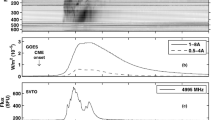Abstract
We present Culgoora spectrograph and radioheliograph observations as well as a model of type IIIb bursts; the latter are defined as chains of striae of slow or no frequency drift, the chain as a whole drifting like a normal type III burst.
The 80 MHz source positions are studied for a group of IIIb bursts, a IIIb precursor and harmonic pairs of 1:2 frequency ratio. It is found that the IIIb position may vary in a IIIb group. No significant difference was found between the source positions of a IIIb precursor and the following III burst. For one event we found that the fundamental IIIb burst showed a high degree of circular polarization (∼46%), while its second harmonic, a normal type III burst, was unpolarized.
We suggest that the main cause for the striae in type IIIb bursts is the existence of filamentary, density irregularities along the path of the electron stream. The denser filaments initially reduce the value of the density gradient along the electrons' path and thereby enhance their emissions over a small range of plasma frequencies. If the radio emission from the filaments dominates the emission from the ambient rarified plasma, striae appear in the spectrum and a type IIIb burst results. This condition is more easily satisfied at the fundamental frequency and for electron streams of relatively high density.
Similar content being viewed by others
References
Alvarez, H. and Haddock, F. T.: 1973,Solar Phys. 29, 197.
de la Noë, J. and Boischot, A.: 1972,Astron. Astrophys. 20, 55.
Ellis, G. R. A. and McCulloch, P. M.: 1967,Australian J. Phys. 20, 583.
Melrose, D. B.: 1974,Solar Phys. 35, 441.
Melrose, D. B. and Sy, W. N.-C.: 1972,Australian J. Phys. 25, 387.
Solar-Geophysical Data: 1973a, No. 352, Part II; 1973b, No. 347, Part I. U.S. Dept. of Commerce, Boulder.
Stewart, R. T.: 1974a, in G. Newkirk (ed.), ‘Coronal Disturbances’,IAU Symp. 57, 161.
Stewart, R. T.: 1974b, ‘An Example of a Fundamental Type IIIb Radio Burst’, to be submitted toSolar Phys.
Takakura, T., Naito, Y., and Ohki, K.: 1973, in R. Ramaty and R. G. Stone (eds.), Proc. NASA Symposium onHigh Energy Phenomena on the Sun, NASA SP-342, p. 573.
Author information
Authors and Affiliations
Additional information
Radiophysics Publication RPP 1758, October, 1974, (2nd version).
On leave from the Dept. of Astronomy, University of Tokyo, Tokyo, Japan.
On leave from the Dept. of Astronomy, Cairo University, Cairo, Egypt.
Rights and permissions
About this article
Cite this article
Takakura, T., Yousef, S. Type IIIb radio bursts: 80 MHz source position and theoretical model. Sol Phys 40, 421–438 (1975). https://doi.org/10.1007/BF00162389
Received:
Revised:
Issue Date:
DOI: https://doi.org/10.1007/BF00162389




